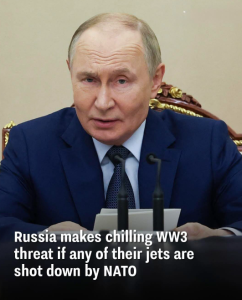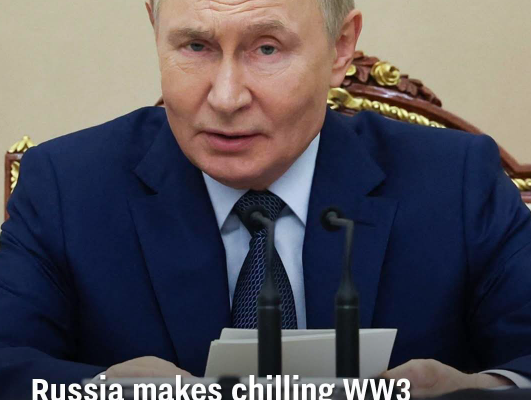
Russia Issues Chilling Warning: Shooting Down Jets Could Trigger War
International tensions reached a boiling point this week after Russia issued a stark and unsettling warning to Western governments: any attempt to shoot down Russian aircraft could be interpreted as an act of war, sparking consequences far beyond the battlefield. The warning, delivered in official statements and echoed through state-controlled media, underscores just how fragile the current geopolitical climate has become. At the heart of the matter lies the ongoing conflict in Eastern Europe, where Russian air operations have increasingly collided—literally and figuratively—with Western interests.
The Warning That Shook the West
Russian officials, including senior military leaders and foreign ministry spokespeople, declared that if Western nations or NATO-aligned forces engage Russian jets, Moscow would treat it as a “direct attack on the sovereignty of the Russian Federation.” In simpler terms, Russia is drawing a red line: tamper with their air power, and the situation could escalate from a proxy conflict into a full-scale confrontation between nuclear-armed powers.
State television amplified the message, with commentators warning that Moscow would not hesitate to respond with overwhelming force. Some even suggested that Russia would reserve the right to retaliate against the countries responsible, whether through conventional strikes, cyberwarfare, or other military measures.
The chilling language was designed not only to warn adversaries but also to rally domestic support at home. By portraying itself as the target of Western aggression, Russia seeks to strengthen public resolve while putting NATO on notice.
Why Airspace Matters
To understand why this warning is so serious, one must look at the role of air power in modern warfare. Control of the skies determines the outcome of ground operations, the safety of supply lines, and the ability to strike enemy positions.
Russia’s air force has been heavily engaged in operations over Ukraine and near NATO’s eastern flank. At the same time, Western nations have provided advanced air-defense systems and intelligence to Ukraine, allowing them to intercept Russian drones, missiles, and even some aircraft. But so far, NATO nations have stopped short of directly shooting down Russian jets themselves, mindful of the catastrophic consequences such an action could unleash.
The Kremlin’s latest warning appears designed to ensure that line remains intact. By reminding the world that Russian aircraft are a red line, Moscow is trying to deter even the hint of Western escalation.
A Dangerous Game of Chicken
Despite the clear threat, the situation on the ground and in the air leaves plenty of room for accidental confrontations. International borders in Eastern Europe are tightly packed, with Russian, Ukrainian, and NATO aircraft often flying near one another. A single miscalculation—a plane straying into contested airspace, a radar operator misidentifying a target—could spark the very scenario Moscow has warned against.
History provides sobering reminders of how such accidents can spiral. In 2015, Turkey, a NATO member, shot down a Russian Su-24 bomber near the Syrian border, claiming it had violated Turkish airspace. Russia responded with economic sanctions and harsh rhetoric, but both sides eventually stepped back from escalation. The difference today is that the conflict in Ukraine has pushed relations between Moscow and the West to their lowest point since the Cold War, making restraint far less certain.
NATO’s Dilemma
For NATO leaders, Russia’s warning creates a difficult balancing act. On one hand, they must continue supporting Ukraine, which relies heavily on Western weapons, intelligence, and training to resist Russian advances. On the other, they must avoid steps that Moscow could interpret as direct military intervention.
NATO has repeatedly stressed that it does not seek war with Russia. Yet the alliance has also promised to defend every inch of its territory. If a Russian jet were to stray into NATO airspace and be shot down, the question would become whether Moscow views it as a defensive act or an attack deserving retaliation. The ambiguity is what makes the situation so volatile.
The Nuclear Shadow
Looming over all of this is Russia’s nuclear arsenal—the largest in the world. Russian leaders have not been shy about reminding adversaries of their capabilities. President Vladimir Putin himself has hinted at “catastrophic consequences” if NATO crosses certain red lines. While many analysts believe nuclear war remains unlikely, the mere possibility adds urgency to every confrontation.
Russia’s warning about shooting down jets must therefore be understood not just as a military threat, but as part of a broader psychological campaign. By raising the specter of world war, Moscow hopes to discourage NATO from taking bolder steps in Ukraine, such as establishing a no-fly zone or supplying more advanced fighter aircraft.
Global Reactions
The international response to Russia’s warning has been mixed. Western officials have condemned Moscow’s rhetoric as reckless and destabilizing, insisting that NATO remains focused on defense, not aggression. However, there is also a recognition that Russia is serious about defending its air power. Behind closed doors, NATO commanders are reportedly revisiting protocols to prevent accidental encounters from spiraling out of control.
In Asia, countries like China have largely stayed quiet, preferring to avoid entanglement in Russia’s confrontation with the West. Yet for nations in Eastern Europe—Poland, the Baltic states, Romania—the warning has only deepened fears that they are living on the front lines of a potential global conflict.
Escalation Risks
What makes this warning especially dangerous is that it leaves so little room for error. The skies are crowded, tensions are high, and communication channels are strained. Even a small clash could trigger retaliation that quickly snowballs out of control.
Analysts warn that the longer the conflict drags on, the greater the risk of escalation. Each new shipment of Western weapons, each Russian missile strike, and each border incident adds fuel to the fire. The Kremlin’s latest warning should therefore be seen as both a threat and a plea: stay out of our airspace, or risk war.
Can Diplomacy Prevent Disaster?
The best hope for avoiding catastrophe lies in renewed diplomacy. Even during the darkest days of the Cold War, Washington and Moscow maintained hotlines to prevent accidents from escalating. Similar communication mechanisms are desperately needed today.
Unfortunately, trust between Russia and the West is at rock bottom. Sanctions, propaganda, and battlefield realities have hardened both sides. Still, without dialogue, the risk of miscalculation remains unacceptably high. Some experts argue that neutral nations or international organizations like the United Nations could play a mediating role in establishing airspace agreements or no-conflict zones.
Conclusion
Russia’s chilling warning about shooting down jets is not mere bluster—it is a clear signal of how easily the current conflict could spiral into something far larger. By declaring its air power untouchable, Moscow is daring NATO to test its resolve. At the same time, the warning underscores the fragility of the situation: one mistake, one misjudgment, could unleash consequences no one wants.
The world stands at a crossroads. Will leaders find a way to de-escalate, or will pride, miscalculation, and mutual suspicion push us closer to the brink? The stakes could not be higher. The skies over Eastern Europe are more than just airspace—they are the front line of a potential global confrontation, one that humanity cannot afford to fight

